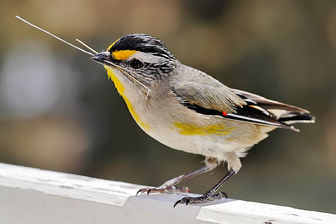Striated Pardalote
Striated Pardalotes occupy a vast range of habitat types, from tall mountain rainforest to arid scrubland, and are found in all parts of Australia except some of the Western Australian deserts.

The Striated Pardalote is classified as Least Concern. Does not qualify for a more at risk category. Widespread and abundant taxa are included in this category.
Striated Pardalote at nest. Striated Pardalote at nest. Photo: G Little © Australian Museum Striated Pardalote. Image from: John Gould (1804-81) The birds of Australia 1840-48. 7 vols. 600 plates Artists: J. Gould and E. Gould; Lithographer: E. Gould. Striated Pardalote. Image from: John Gould (1804-81) The birds of Australia 1840-48. 7 vols. 600 plates Artists: J. Gould and E. Gould; Lithographer: E. Gould. More
The Striated Pardalote (left or above in a nice shot by Ed Harper) comes in a variety of fairly distinctive plumages across a broad geographic range, and has been split by some into as many as four or five species. The one shown here is the nominate race P. s. striatus, the "Yellow-tipped Pardalote" that breeds in Tasmania and is migratory widely throughout southeast Australia. Most of the population leaves Tasmania in the fall and winters as far north as Queensland. More
The Striated Pardalote contains six subspecies that are sometimes elevated to four separate species, and one subspecies of the Spotted Pardalote is sometimes treated as a separate species. Within the family the relationships between the subspecies are unclear, although it is thought that the Forty-spotted Pardalote is closely related to the Spotted Pardalote. Description and morphology - The pardalotes are small, compact birds that range in size from 8.5-12 cm in length. More
The Striated Pardalote (Pardalotus striatus) is the least colourful and most common of the four pardalote species. It is a very small, short-tailed bird that is more often heard than seen, foraging noisily for lerps and other small creatures in the treetops. Striated Pardalotes occupy a vast range of habitat types, from tall mountain rainforest to arid scrubland, and are found in all parts of Australia except some of the Western Australian deserts. More
Striated Pardalotes are most abundant in August and March and were exceptionally so (up to 200 for one observation) in August and September of 1992. There appears to be a slight downward trend in numbers since 1986. They nest in small hollows, normally in trees, but sometimes in man-made structures. They breed mostly from September to March, although nesting has been recorded in July and dependent young observed in January. R=23. BR=18. More
Striated pardalote from sat morning. Not as sharp as i would have liked and not as close either - I learn. That first bird is stunning, nice capture Some lovely shots Brett. The Pardalote is gorgeous the pardalote shot a spotted today myself cheers Really beautiful and clean shots. LOVE the rain shot, can say photoforum.com. More
The Striated Pardalote is a small bird (90-115mm) that shows considerable variation in plumage across its range. All birds have white eyebrows with a yellow spot in front of the eye, olive-grey backs and a white stripe in the wing with a red or yellow coloured spot at the front. The black crown may have or lack fine white stripes. Males and females are similar in plumage and young birds are notably paler on the crown and face. More
This Striated Pardalote (Pardalotus striatus) spotted on the road to Deniliquin NSW was nesting in a hollow right under neath a large raptors nest (Square Tailed Kite I think). Talk about a brave bird (or very smart!!). More
Another Striated Pardalote capture… this being a juvenile I believe, so the striations on the top of the head are not as pronounced. Murringo Creek NSW Australia. * Striated Pardalote by Sharon Wormleaton Striated Pardalote Pardalotus striatus. Photo taken in central Queensland. More
The Striated Pardalote (Pardalotus striatus), is a species of bird that occupies a vast range of habitat types, from tall mountain rainforest to arid scrubland, and are found in all parts of Australia except some of the Western Australian deserts. There are four recognized subspecies: The Yellow-tipped Pardalote (race striatus), is, found mainly in Tasmania, but crosses the 200 miles of Bass Strait to the mainland each winter in a migration. More

Original source: #if:29629438@N00|Ric Raftis|#if:|
Author: #if:29629438@N00|Ric Raftis|#if:|
Permission: Some rights reserved
Family : Pardalotidae
Genus : Pardalotus
Species : striatus
Authority : (Gmelin, 1789)

